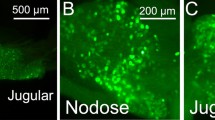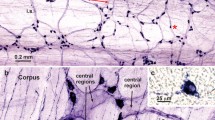Abstract
Intramuscular arrays are one of two major classes of vagal afferent mechanoreceptors that innervate the smooth muscle wall of the proximal gastrointestinal tract. They consist of rectilinear telodendria that distribute in the muscle sheets, parallel to the long axes of muscle fibers. Intramuscular arrays appear to make direct contact with the muscle fibers, but they also course on, and form appositions with, intramuscular interstitial cells of Cajal. These complexes formed by intramuscular arrays and intramuscular interstitial cells of Cajal suggest that intramuscular arrays might require either structural or trophic support of the interstitial cells of Cajal for normal differentiation and/or maintenance. To evaluate this hypothesis, we have examined the morphology and distribution of vagal afferent endings in the c-Kit mutant mouse that lacks intramuscular interstitial cells of Cajal. Vagal afferents were labeled by nodose ganglion injection of either wheat germ agglutinin-horseradish peroxidase conjugate or a tagged dextran, and the labeled afferent terminals in the stomach were mapped using a standardized quantitative sampling scheme. Intramuscular arrays were dramatically reduced (in circular muscle by 63%; in longitudinal muscle by 78%) in the c-Kit mutant mice relative to their wild-type littermates. Additionally, a substantial number of the surviving axons and terminals in the mutant stomachs were morphologically aberrant. Moreover, the loss of intramuscular arrays in mutants appeared to be selective: the structure, distribution and density of intraganglionic laminar endings, i.e., the other vagal mechanoreceptors in smooth muscle, were not significantly altered. Finally, the conspicuous decrease in intramuscular array density in mutants was associated with a non-significant trend toward loss of nodose ganglion neurons. Collectively these findings suggest that interstitial cells are required for the normal development or maintenance of vagal intramuscular arrays. Therefore, the c-Kit mutant mouse will be valuable for determining the role(s) of interstitial cells in intramuscular array development as well as for providing an animal model with the intramuscular array class of vagal afferents selectively ablated.
Similar content being viewed by others
Author information
Authors and Affiliations
Additional information
Accepted: 14 March 2001
Rights and permissions
About this article
Cite this article
Fox, E., Phillips, R., Martinson, F. et al. C-Kit mutant mice have a selective loss of vagal intramuscular mechanoreceptors in the forestomach. Anat Embryol 204, 11–26 (2001). https://doi.org/10.1007/s004290100184
Issue Date:
DOI: https://doi.org/10.1007/s004290100184




